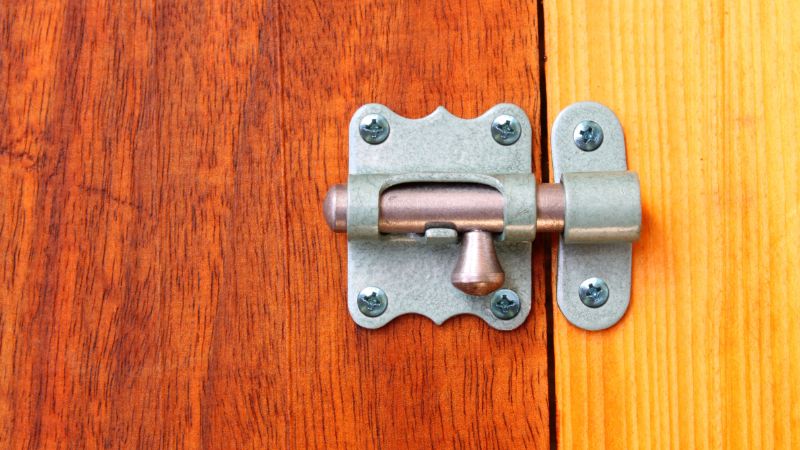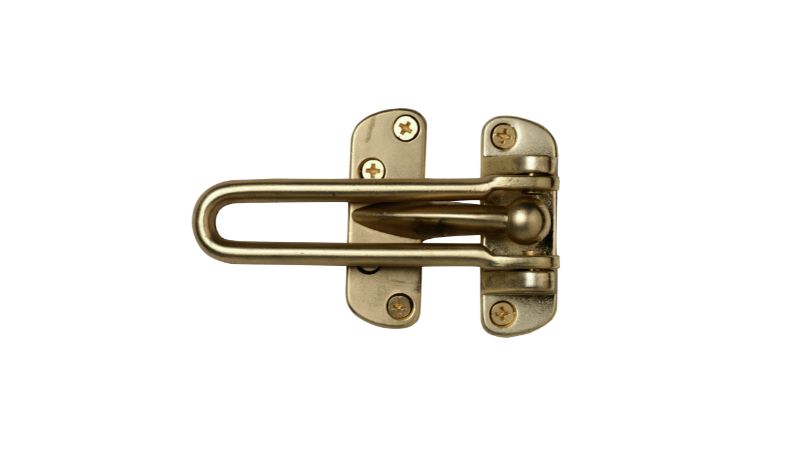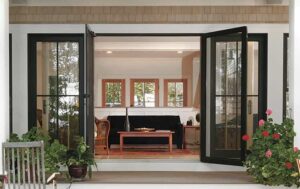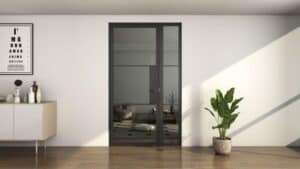Doors are a vital part of any building, ensuring security, privacy, and protection. Central to their function is the door latch, a simple mechanism that keeps doors securely closed until needed.
Door latches come in various types, each designed for specific applications, from the standard spring bolt latches found in most interior doors to sophisticated electronic smart latches that offer keyless entry options.

Understanding The Basic Latch Mechanism
The mechanism may seem simple, but there’s fascinating engineering behind how these everyday devices work.
What Is A Door Latch?
A door latch is a mechanical fastener that secures a door to its frame. It typically consists of a spring-loaded bolt that extends into a strike plate mounted on the door jamb. When the door closes, the beveled edge of the bolt hits the strike plate and compresses.
Once aligned with the hole in the strike plate, the spring pushes the bolt forward, securing the door in place. Most latches are part of a larger door hardware assembly that includes handles or knobs for operation.
Door latches come in various sizes and configurations depending on their intended use. Residential doors usually feature simpler mechanisms, while commercial applications often require more robust designs for security and frequent use.
How Does A Latch Work?
The basic latch operation relies on a few key components working together. When you turn a doorknob or handle, it retracts the latch bolt against its spring tension, allowing the door to open.
The spring mechanism is crucial as it provides the constant force needed to keep the latch extended when the door is closed. This automatic re-engagement is what makes latches so effective for everyday use.
Most modern latches use a tubular design where all components fit inside a cylindrical housing drilled into the door edge. The latch bolt connects to the handle via a spindle or tailpiece that transfers the turning motion.
Simple latch types include:
- Tubular latches
- Mortise latches
- Rim latches
The beveled edge of the latch bolt is an ingenious feature that allows doors to close automatically without needing to retract the bolt manually. When pushed against the strike plate, the angle forces the bolt inward until it aligns with the hole.
Types Of Door Latch
Door latches come in various designs, each offering unique functionality and security features suited for different applications ranging from residential interior doors to high-security exterior entrances.
Tubular Latch
Tubular latches are among the most common types found in residential properties. They feature a cylindrical body that fits into a hole drilled in the door edge. These latches have a spring-loaded bolt that retracts when the handle is turned.
Installation is relatively straightforward, making them popular for DIY projects. A standard tubular latch requires a 25mm hole in the door edge and a 54mm hole through the door face.
Tubular latches come in different backset measurements (the distance from the door edge to the center of the handle). Common sizes include 60mm, 70mm, and 95mm.
Most tubular latches are reversible, meaning they can be installed on doors that open from either the left or right side.
Night Latch
Night latches, also known as Yale locks, provide additional security for external doors. They automatically lock when the door closes but can be opened from inside without a key.
From the outside, a key is required to gain entry. This dual functionality makes night latches particularly useful for main entrances to homes and apartments.
Most night latches feature a snib or catch that can hold the bolt back when needed. This allows free movement through the door without automatically locking.
Higher security models offer deadlocking functions that prevent the bolt from being forced back when the door is closed. Night latches are typically surface-mounted on the interior side of the door.
Thumb Latch
Thumb latches blend functionality with decorative appeal. They operate with a thumb-press mechanism on one side and often a handle or lever on the other.
These latches are especially popular for cottage-style homes, garden gates, and rustic interior doors. Traditional designs feature ornate backplates with a thumb-operated lever.
Modern thumb latches maintain the classic appearance while incorporating improved materials and mechanisms. They typically don’t provide high security on their own.
For outdoor applications, look for weather-resistant finishes like brass, bronze, or powder-coated metals. Some thumb latches can be paired with deadbolts for additional security when used on exterior doors.

Mortice Latch
Mortice latches require a pocket (mortice) to be cut into the door edge. They sit flush with the door, creating a cleaner appearance than surface-mounted options.
These latches use a spring-loaded bolt that engages with the strike plate on the door frame. Standard mortice latches don’t include a locking mechanism but provide a secure closure.
For better security, many homeowners pair mortice latches with separate deadlocks. Installation requires precise measurements and specialized tools, making it generally better suited for professional installation.
Mortice latches come in various sizes and finishes to match door thickness and interior design. They’re commonly used with lever handles or doorknobs in both residential and commercial settings.
Bolt Latches
Bolt latches use a simple sliding mechanism to secure doors. They feature a metal bolt that slides into a receiving bracket mounted on the door frame.
These latches are commonly used for bathroom stalls, garden gates, sheds, and other applications where moderate security is needed. They can be surface-mounted, making installation relatively simple.
Many bolt latches include a way to secure them with a padlock for additional security. They’re available in various sizes, from small cabinet latches to heavy-duty gate bolts.
For outdoor use, look for weather-resistant materials like stainless steel or galvanized metal. Some decorative bolt latches feature ornate designs that add visual appeal while maintaining functionality.
Suffolk Latches
Suffolk latches are traditional ironmongery with historical roots in English cottages. They feature a thumb-operated bar on one side and a catch plate on the other.
The distinctive design includes a backplate, often in a decorative shape, with an attached lifting bar. When the thumb-piece is pressed, it lifts the bar from its catch, allowing the door to open.
These latches are primarily chosen for their aesthetic appeal in period properties. Modern reproductions maintain the traditional appearance while incorporating improved mechanisms.
Suffolk latches are typically made from black iron or wrought iron. They work well for interior doors in country-style homes or heritage buildings where authentic detailing is desired.
Ring Latches
Ring latches feature a pull ring on one or both sides of the door. When pulled, the ring operates a mechanism that releases the latch.
These latches are popular for gates, cabinets, and decorative interior doors. Traditional designs often include ornate backplates with detailed scrollwork around the ring.
For outdoor applications, choose weather-resistant materials like brass, bronze, or coated steel. Many ring latches provide minimal security but excellent aesthetic appeal.
Some designs incorporate a locking mechanism for additional security. Ring latches are relatively easy to install and can be a DIY-friendly project for most homeowners.
Roller Bolt
Roller bolt latches use a spring-loaded roller that engages with a strike plate. The roller compresses when the door closes and expands to hold it shut.
These latches are ideal for doors that need to close securely without requiring a handle to operate them. They’re commonly used for closet doors, bathroom stalls, and cabinet doors.
Roller bolts provide minimal security but excellent convenience. The tension in the spring can usually be adjusted to provide the desired resistance.
Installation is straightforward, requiring only basic tools. Most roller bolts are available in various finishes to match existing door hardware and interior design elements.
Sliding Bolt
Sliding bolts provide simple, reliable security for doors, windows, and gates. They consist of a bolt that slides into a receiving bracket or slot.
These latches are available in various sizes, from small cabinet bolts to heavy-duty security bolts for main doors. Many designs include features for padlocks to be attached for additional security.
For exterior applications, weather-resistant materials like stainless steel or brass are recommended. Sliding bolts can be surface-mounted, making them relatively easy to install without specialized tools.
Some sliding bolts feature flush designs that sit within the door rather than on the surface. These provide a cleaner appearance but require more complex installation.

Choosing The Right Door Latch
Selecting an appropriate door latch requires careful consideration of your specific needs and the door’s purpose. The right latch will balance functionality, security, and aesthetic appeal while meeting your practical requirements.
Factors To Consider
Door location plays a crucial role in latch selection. Exterior doors typically require more robust latches with higher security features than interior doors.
The door’s thickness and material will limit your options, as certain latches are designed for specific door dimensions. Always measure your door before purchasing any hardware.
Consider the door’s frequency of use. High-traffic doors benefit from durable latches that can withstand constant operation without failing.
Weather exposure is another important factor. Exterior latches should be weather-resistant, ideally made from materials like brass, stainless steel, or treated metal to prevent corrosion.
Aesthetic considerations shouldn’t be overlooked. The latch should complement your door’s design and the overall style of your space.
Level Of Security Needed
For primary entry points, consider deadbolt latches which provide superior security. They don’t spring back when closed and can only be moved by rotating the key or knob.
Smart latches offer keyless entry through codes, fingerprints, or smartphone connectivity. They provide convenience while maintaining security records of entry times.
Privacy latches are suitable for bathrooms and bedrooms. They lock from the inside only and often include emergency access features.
For closets and utility spaces, passage latches without locking mechanisms are typically sufficient. These simple latches keep doors closed but don’t provide security.
When security is paramount, look for ANSI-graded latches (American National Standards Institute). Grade 1 offers the highest security, while Grade 3 provides basic functionality for interior doors.
If you’re looking for a latch that balances elegant design with top-notch security, the selection from Tengyu provides excellent choices. Their latches are designed for various applications, blending functionality and style seamlessly.
Maintaining Your Door Latch
Regular maintenance of your door latch ensures smooth operation and extends its lifespan. Proper care prevents common issues like sticking or misalignment that can lead to frustration and security concerns.
Common Issues And Fixes
Door latches often develop issues that can be easily fixed with simple maintenance. Sticking latches typically result from dirt buildup or lack of lubrication. Clean the latch mechanism with a soft cloth and apply a small amount of graphite lubricant or silicone spray.
Misaligned latches prevent doors from closing properly. Check if the strike plate aligns with the latch bolt and adjust it by loosening the screws and repositioning as needed.
Loose handles indicate worn internal components or loose screws. Tighten all visible screws on the handle assembly and faceplate with a screwdriver.
Squeaking hinges affect latch performance too. Apply lubricant to the hinge pins to ensure smooth door movement, which reduces strain on the latch mechanism.
When To Replace Your Door Latch
Door latches typically last 7-10 years with proper maintenance. Signs of needed replacement include persistent sticking even after cleaning and lubrication, or visible damage to the latch bolt or mechanism.
Security concerns should prompt immediate replacement. If the latch doesn’t fully extend or retract, it compromises your home’s security.
Consider upgrading when:
- The finish is severely worn or doesn’t match updated décor
- The mechanism feels loose or “sloppy” when operating
- Parts are visibly broken or missing
- The latch frequently fails to engage with the strike plate
Modern replacement options offer improved security features like reinforced strike plates and longer throw bolts. Smart latches provide keyless entry and remote locking capabilities for enhanced convenience.






